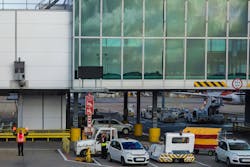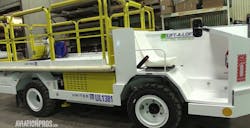It’s Time to Tackle the Issue of Vehicle-to-Vehicle Incidents
The Flight Safety Foundation estimates that ramp accidents cost airlines around $10 billion each year, with vehicle collisions contributing significantly to this figure. For instance, it’s estimated that damage to aircraft occurs roughly once every 1,000 flights – and if an aircraft is damaged on the ramp, it will be unavailable for approximately three to four days, incurring an average cost of $225,000 per aircraft.
Small Incidents Escalate
However, these ‘big’ incidents involving collisions with aircraft often have much smaller beginnings. Minor vehicle-to-vehicle incidents airside, such as those involving rover vehicles, baggage tugs, pushback tractors, hi-loaders and other ground support equipment (GSE), can – and do – escalate into much bigger problems in the airside environment.
In our experience, many drivers don’t report vehicle-to-vehicle incidents. And when they do, they are not investigated or even recorded in the same manner as an incident involving an aircraft.
However, all vehicle-to-vehicle incidents should be reported, not only to comply with the guidelines of the International Air Transport Association (IATA), but also because a robust system of reporting and analysis will help operators investigate the root causes and find ways to prevent incidents from happening again.
The Dangers of Unreported Damage
That said, unreported damage to a vehicle, or infrastructure, is all too common, and is usually left to worsen over time, making it more expensive to fix, while extending downtime and increasing the potential impact on all-important aircraft turnaround times.
One of the biggest issues, and costs, arises where impaired equipment causes damage to aircraft, escalating a small incident into a much larger and more expensive problem. For instance, if a van makes light contact with a hi-loader when parking, a sensor could get damaged which could then cause the hi-loader to later come in contact with an aircraft.
The five equipment types that most commonly cause damage to aircraft on the ramp are ULDs (unit load devices), pedestrian steps, cargo loaders, belt loaders and pushback tractors (as per IATA’s Ground Damage Database 2017). These types of vehicle-to-aircraft incidents are reported to contribute to the $5 billion per year that airlines have to spend on aircraft repair alone, downtime and delay costs, according to the Flight Safety Foundation.
These issues are one of the reasons why ground handling operations can be a major challenge to profitability for airside operations. In fact, IATA estimates that our industry could save up to an estimated $4 billion per year by improving safety and reducing damage to aircraft, vehicles and ground support equipment.
Managing Factors Within Your Control
Ground accidents and incidents airside are one of the few factors impacting profitability and safety that organizations can control and influence, unlike taxes and fuel prices. With the right approach, our industry can positively influence accident and incident rates to reduce damage and the associated costs of ground handling incidents. Yet managers and directors still often overlook the real cost of minor vehicle-to-vehicle incidents, with no plan or system in place to tackle the problem and little data available to understand the issue.
We will often look to automation to reduce GSE and vehicle incident rates. We retrofit sensors or purchase equipment that has sensors; we issue safety notices or perhaps carry out toolbox talks; and standard operating procedures (SOPs) are often reviewed and updated post incident.
All have merit and are useful, but what about fixing the real reason behind the incidents? The actual behavior and influence that led to the incident. It is well known that human factors play a role in incidents such as behavior and performance. But what about the things that influence the behavior and performance?
Do we pay enough attention to the behavior of ground staff and the factors that affect their behavior? What affects a GSE driver’s decision-making and risk-taking behavior, and can we identify the potential for these behaviors in our people?
Three of the major factors influencing vehicle and GSE driver behavior are pressure/stress, fatigue and distractions, but these are often overlooked as contributing factors when it comes to airside vehicle accidents.
Pressure, Fatigue and Distraction
Pressure can be healthy, as it provides drive and motivation. However, too much pressure leads to stress and can have a negative impact on driver behavior and performance. Being able to identify the signs of stress, and then being able to combat it, gives us a very real opportunity to reduce vehicle to vehicle incidents and accidents.
Stress and pressure can lead to fatigue, as can repetitive work, time of day and long shifts. Fatigue and driving are a dangerous combination. However, an ability to identify the symptoms of fatigue, such as long blinks, vacant stares and heavy eyelids, in themselves and others will enable GSE drivers to highlight this issue and take steps to prevent a negative outcome of the fatigue.
Distracted driving is another element which adds huge risk to your operations when it comes to vehicle-to-vehicle collisions. Improving awareness of distractions and ensuring drivers have techniques to avoid distractions are very useful ways of reducing the risks of vehicle incidents caused by risk taking, poor judgment or “looking but not seeing.” The perception of risk also decreases over time, so regular correction of bad habits is also important.
Tackling Incidents Through Training
Research from the Flight Safety Foundation has shown that human error is involved in most airside accidents. Vehicle-to-vehicle incidents are clear indicators that there is a weakness in driver training or supervision. They are an indicator that risks exist and have the potential to escalate swiftly when the vehicle-to-vehicle becomes a vehicle-to-aircraft accident.
The good news is that engaging, specific, relevant and high-quality training has the power to address these issues. Through training, we can help improve accuracy and ensure safe operations. For instance, an operator using a belt loader carefully and precisely is less likely to come in contact with an aircraft. This avoids the delays, repairs and costs of passenger compensations that could be incurred. More importantly, it helps avoid potentially catastrophic airside accidents.
The right training, supported by well-trained managers, team leaders and supervisors can also combat issues such as fatigue, stress and distraction by teaching techniques for being aware of, and preventing, these issues and in turn, vehicle-to-vehicle incidents. As well as less damage to aircraft, this results in less downtime and delays and lower GSE/vehicle maintenance costs.
Standardizing your training content and delivery is another important way that operations can reduce incidents, while also improving efficiency and safety. Tailored airside equipment training, made to meet your specific airport operating environment, can help ensure that all operators have the same high level of skill for safe GSE operations. It can also help your operators to develop greater situational awareness and a greater appreciation of airside safety. This, in turn, can help all parties involved in aircraft turnaround and airside operations to work together more harmoniously.
Training is also an important way to teach ground handling operators the required processes and systems for reporting incidents. However, in our experience, we have seen time and again that airside operations that encourage a team ethic and open communication are safer, as well as more productive. You should create an environment where your airside operatives are encouraged to speak up if they see anything happening that could affect safety.
Conclusion
The danger our industry faces is that unreported airside incidents become the norm in day-to-day operations, costing time and money and reinforcing a poor airside safety culture. By increasing safety and reducing aircraft, vehicle- and GSE-damage, it is estimated that $4 billion could be saved each year (IATA).
While high quality training alone cannot solve 100 percent of the challenges faced by airside operations, it can make a huge contribution to reducing the depth of the problems.
Addressing behaviors, challenging complacency and ensuring delivery of the correct driver training and supervision all help to reduce accidents and incidents. This improves efficiency, driving down the costs of repairs and downtime and makes the airside environment a safer place for staff and passengers alike.
Laura Nelson is Managing Director of RTITB Airside, a specialist consultancy dedicated to reducing GSE and Airside Ops vehicle accidents and incidents. Nelson and her team have worked with airports across the world in pursuit of this objective providing audits, consultancy, train-the-trainer courses and customized training materials and courseware. Sites RTITB Airside has worked with include Stansted Airport, Heathrow Airport, Gatwick Airport and Changi Airport.





